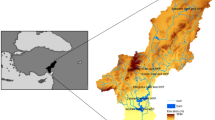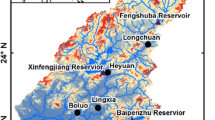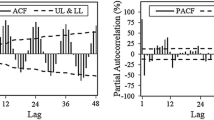Abstract
Forecasting flow in rivers has special significance in surface water management, especially in agricultural planning and risk reduction of floods and droughts. In recent years, studies have shown the superiority of forecasting models based on artificial intelligence, using artificial neural networks (ANN) and genetic programming (GP), over time-series models. In this paper, continuous and discrete historical flow records are used for monthly river flow forecasting of the Saeed-Abad river in East Azarbaijan province, Iran. Auto regressive moving average with exogenous inputs (ARMAX), ANN, and GP models are used in both continuous and discrete flow series. For both flow series, results of the ARMAX, ANN, and GP models are then compared and results of each method are evaluated relative to each other. Two quantitative standard statistical performance evaluation measures, coefficient of determination (R2) and root mean square error (RMSE), are employed to evaluate the performance of the aforementioned models. Results show that for the two methods, the GP model is more effective with respect to accuracy than ARMAX and ANN. For continuous time-series forecasting, GP is a more precise model (R 2 = 0.7 and RMSE = 0.172) than either ANN (R 2 = 0.627 and RMSE = 0.193) or ARMAX (R 2 = 0.595 and RMSE = 0.243). For discrete time-series forecasting, the superiority of the GP model is evident in most months. For monthly flow forecasting, results indicate that the discrete time-series forecasting method is superior to the continuous time-series forecasting method.











Similar content being viewed by others
References
Akbari-Alashti H, Bozorg Haddad O, Fallah-Mehdipour E, Mariño MA (2013) Multi-reservoir real-time operation rules: a new genetic programming approach. Proc Inst Civ Eng Water Manage. doi:10.1680/wama.13.00021
Banzhaf W, Nordin P, Keller R, Francone FD (1998) Genetic programming: an introduction. Morgan Kaufmann Publishers Inc, San Fransisco
Bhattacharya B, Solomatine DP (2005) Neural networks and M5 model trees in water level- discharge relationship. J Neurocomput 63:381–396
Bozorg Haddad O, Mariño MA (2011) Optimum operation of wells in coastal aquifers. Proc Inst Civ Eng Water Manage 164(3):135–146. doi:10.1680/wama.1000037
Bozorg Haddad O, Adams BJ, Mariño MA (2008) Optimum rehabilitation strategy of water distribution systems using the HBMO algorithm. J Water Supply Res Technol AQUA 57(5):327–350
Bozorg Haddad O, Moradi-Jalal M, Mirmomeni M, Kholghi MKH, Mariño MA (2009) Optimal cultivation rules in multi-crop irrigation areas. Irrig Drain 58(1):38–49
Bozorg Haddad O, Mirmomeni M, Zarezadeh Mehrizi M, Mariño MA (2010a) Finding the shortest path with honey-bee mating optimization algorithm in project management problems with constrained/unconstrained resources. Comput Optim Appl 47(1):97–128
Bozorg Haddad O, Mirmomeni M, Mariño MA (2010b) Optimal design of stepped spillways using the HBMO algorithm. Civ Eng Environ Syst 27(1):81–94
Bozorg Haddad O, Afshar A, Mariño MA (2011a) Multireservoir optimisation in discrete and continuous domains. Proc Inst Civ Eng Water Manage 164(2):57–72. doi:10.1680/wama.900077
Bozorg Haddad O, Moradi-Jalal M, Mariño MA (2011b) Design-operation optimisation of run-of-river power plants. Proc Inst Civ Eng Water Manage 164(9):463–475. doi:10.1680/wama.2011.164.9.463
Campolo M, Soldati A, Andreussi P (2003) Artificial neural network approach to flood forecasting in the River Arno. Hydrol Sci J 48(3):381–398
Chau KW (2006) Particle swarm optimization training algorithm for ANNs in stage prediction of Shing Mun River. J Hydrol 329(3–4):363–367
Coulibaly P, Anctil F, Bobee B (2000) Daily reservoir inflow forecasting using artificial neural networks with stopped training approach. J Hydrol 230:244–257
Discipulus owner’s manual (1998) RML Technologies: Littleton Co. http://www.rmltech.com/. Accessed 30 Mar 2014
Fallah-Mehdipour E, Bozorg Haddad O, Mariño MA (2011a) MOPSO algorithm and its application in multipurpose multireservoir operations. J Hydroinf 13(4):794–811
Fallah-Mehdipour E, Bozorg Haddad O, Beygi S, Mariño MA (2011b) Effect of utility function curvature of Young’s bargaining method on the design of WDNs. Water Resour Manag 25(9):2197–2218
Fallah-Mehdipour E, Bozorg Haddad O, Mariño MA (2012a) Real-time operation of reservoir system by genetic programming. Water Resour Manag 26(14):4091–4103
Fallah-Mehdipour E, Bozorg Haddad O, Rezapour Tabari MM, Mariño MA (2012b) Extraction of decision alternatives in construction management projects: application and adaptation of NSGA-II and MOPSO. Expert Syst Appl 39(3):2794–2803
Fallah-Mehdipour E, Bozorg Haddad O, Mariño MA (2013a) Developing reservoir operational decision rule by genetic programming. J Hydroinf 15(1):103–119
Fallah-Mehdipour E, Bozorg Haddad O, Mariño MA (2013b) Extraction of multicrop planning rules in a reservoir system: application of evolutionary algorithms. J Irrig Drain Eng 139(6):490–498
Haltiner JP, Salas JD (1988) Short-term forecasting of snowmelt runoff using ARMAX models. Am Water Res Assoc 24(5):1083–1089
Karamouz M, Araghinejad SH (2004) Application of artificial neural networks and fuzzy inference system in long-term streamflow forecasting. Hydroinformatics, Singapore
Karimi-Hosseini A, Bozorg Haddad O, Mariño MA (2011) Site selection of raingauges using entropy methodologies. Proc Inst Civ Eng Water Manage 164(7):321–333. doi:10.1680/wama.2011.164.7.321
Koza JR (1992) Genetic programming: on the programming of computers by means of natural selection. MIT Press, Cambridge
Koza JR (1994) Genetic programming II: automatic discovery of reusable programs. MIT Press, Cambridge
Muttil N, Chau KW (2006) Neural network and genetic programming for modelling coastal algal blooms. Int J Environ Pollut 28(3–4):223–238
Noory H, Liaghat AM, Parsinejad M, Bozorg Haddad O (2012) Optimizing irrigation water allocation and multicrop planning using discrete PSO algorithm. J Irrig Drain Eng 138(5):437–444
Orouji H, Bozorg Haddad O, Fallah-Mehdipour E, Mariño MA (2013) Estimation of Muskingum parameter by meta-heuristic algorithms. Proc Inst Civ Eng Water Manage 166(6):315–324. doi:10.1680/wama.11.00068
Overman E (2011) A MATLAB tutorial. Department of Mathematics, The Ohio State University, Columbus, p 180
Reinsal GC (1997) Elements of multivariate time series analysis. Springer-Verlag New York Inc, New York
Salas JD, Delleur JW, Yevjevich V, Lane LW (1988) Applied modeling of hydrological time series. Water Resources Publication, Littleton
Savic DA, Walters GA, Davidson JW (1999) A genetic programming approach to rainfall-runoff modeling. Water Resour Manag 13(3):219–231
Seifollahi-Aghmiuni S, Bozorg Haddad O, Omid MH, Mariño MA (2011) Long-term efficiency of water networks with demand uncertainty. Proc Inst Civ Eng Water Manage 164(3):147–159. doi:10.1680/wama.1000039
Seifollahi-Aghmiuni S, Bozorg Haddad O, Omid MH, Mariño MA (2013) Effects of pipe roughness uncertainty on water distribution network performance during its operational period. Water Resour Manag 27(5):1581–1599
Shokri A, Bozorg Haddad O, Mariño MA (2013) Algorithm for increasing the speed of evolutionary optimization and its accuracy in multi-objective problems. Water Resour Manag 27(7):2231–2249
Sivapragasam C, Vasudevan G, Vincent P (2007) Effect of inflow forecast accuracy and operating time horizon in optimizing irrigation release. Water Resour Manag 21(6):933–945
Wang W-C, Chau K-W, Cheng C-T, Qiu L (2009) A comparison of performance of several artificial intelligence methods for forecasting monthly discharge time-series. J Hydrol 374(3–4):294–306
Weron R (2000) Modeling and forecasting electricity loads and prices: a statistical approach. Wiley, Southern Gate
Author information
Authors and Affiliations
Corresponding author
Rights and permissions
About this article
Cite this article
Akbari-Alashti, H., Bozorg Haddad, O. & Mariño, M.A. Evaluation of a Developed Discrete Time-Series Method in Flow Forecasting Models. Water Resour Manage 29, 3211–3225 (2015). https://doi.org/10.1007/s11269-015-0991-1
Received:
Accepted:
Published:
Issue Date:
DOI: https://doi.org/10.1007/s11269-015-0991-1




